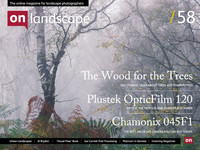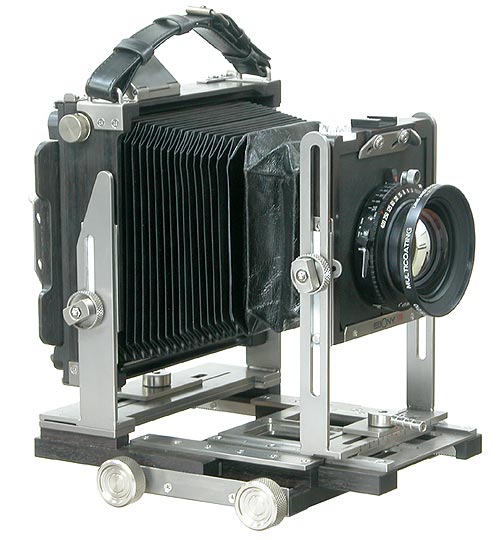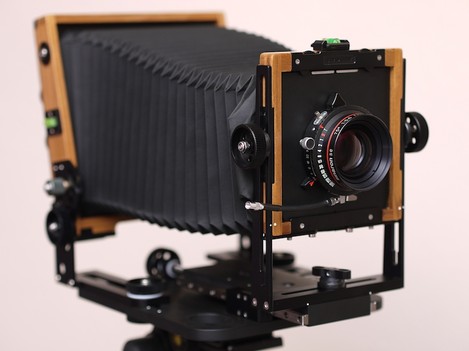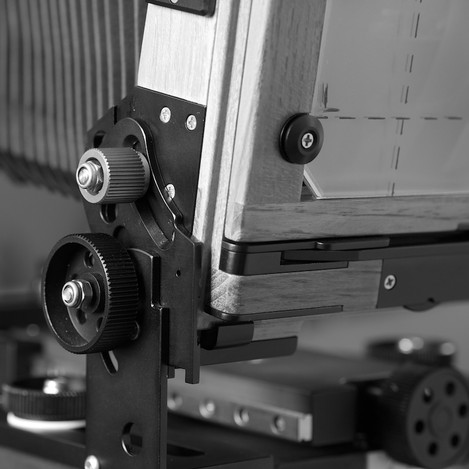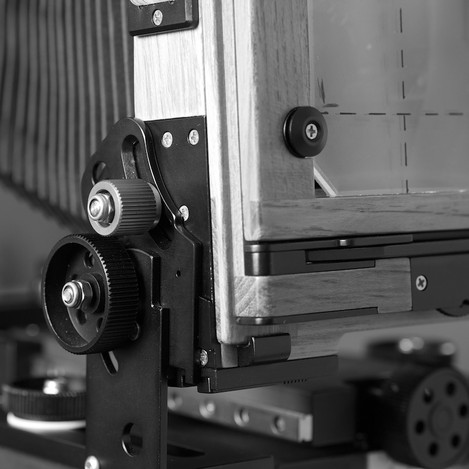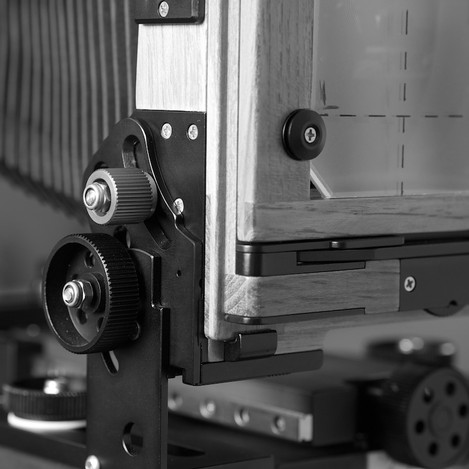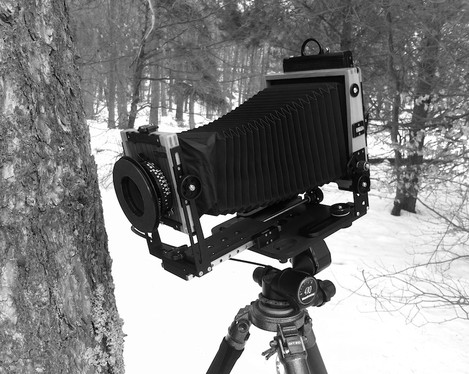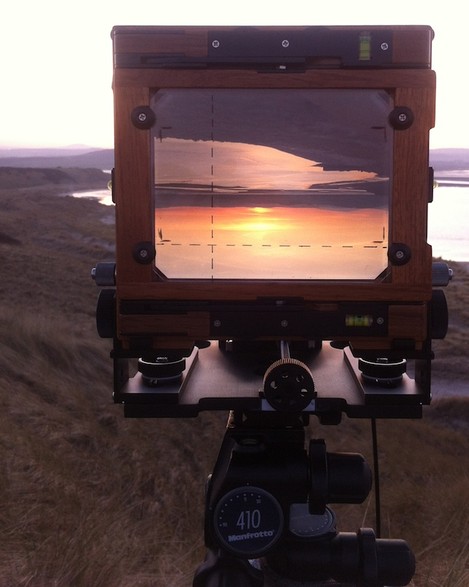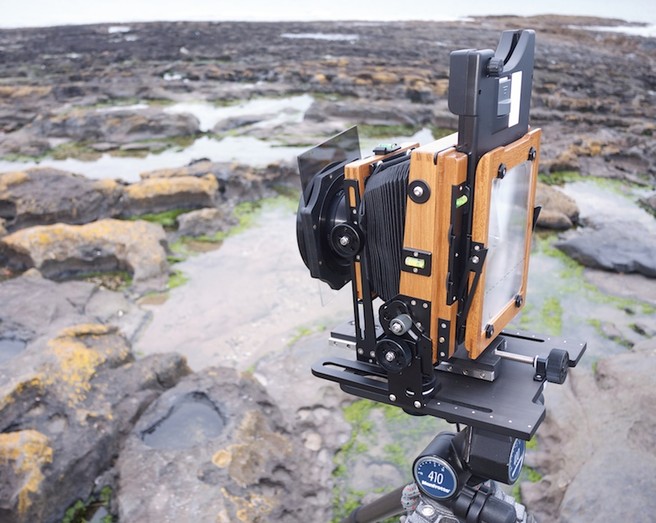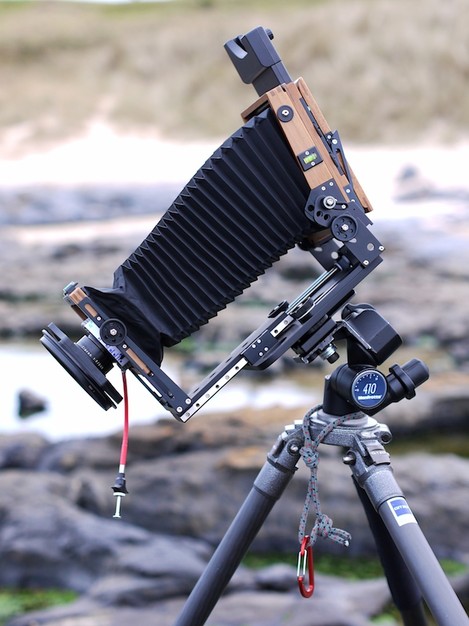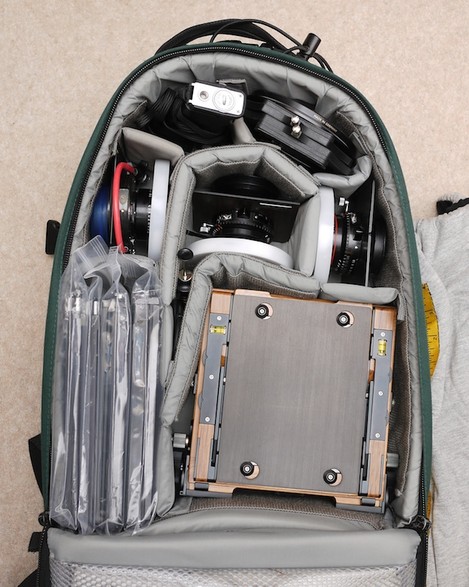Asymmetric tilts come to the masses
Intro
For many years a couple of Ebony models ruled the roost when it came to the top level of luxury in 5x4 field cameras. The two Ebony models bearing the magic designation of "U", the 45SU and SV45U, were unique in that they offered asymmetric tilt and swing on the rear standard, something that was otherwise only found on some models of the bulky Sinar studio monorails.
It seems that asymmetric movements were originally devised to make life easier and quicker for studio work shooting products or tabletop work, but many landscape photographers toting the top-end Ebony models have found them to be pretty useful for getting set up quickly in changing light with a minimum of frustration. I'll not go into an in-depth description of the advantages of asymmetric movements here but to keep it short it means that for many shots using tilt to increase the apparent depth of field you don't have to go through an iterative process of focusing, tilting, refocusing, tilting again, refocusing again, tilting again etc.
The 45SU and SV45U quickly became the must-have 4x5 cameras for many working pros or well-heeled amateurs, despite the weight and cost penalty. Both models weigh in at over 3kg and currently over £4,500 brand new, and second hand dealers currently want over £2.5k for a used camera. Among British photographers especially the 45SU was the model of choice for anyone who could afford it and/or justify its price, as undoubtedly the influence of Joe Cornish played a part in this, Joe being a 45SU owner for many years.
As an amateur, the 45SU always felt like one of those cameras you'd buy if you won the lottery, but as I don't play the lottery I was resigned to never owning one. So I was quite happy with my "poverty" model, the short-bellows Ebony RSW45 which I'll mention in passing during this review. For what it's designed for, that is lenses up to 180mm, it is superb. Simple, exceptionally well made and easy to use, but still not cheap despite being the bottom-of-the-range model. The thought of shelling out a few grand to upgrade to a 45SU is quite a step, but it was the only way you’d ever get those asymmetric tilts…...
Until now
On the largeformatphotography.info forum earlier this year Hugo Zhang, the public face of Chamonix cameras posted up that there would be a new 5x4 model of camera out this year. The posting initially boasted the camera would be yaw-free, which wouldn't necessarily have interested me, but as it turned out they actually meant this new 045F1 model had asymmetric rear tilt. Now, this really got my attention, as it is to my knowledge the first and only sub-£4,000 field camera to offer the photographer the comparative luxury of asymmetric tilts. I'd been toying with the idea of getting a camera with longer bellows for a while, probably a Chamonix, so this addition of asymmetric tilts pushed me over the edge. The cost at the time of writing this is $1,030 plus $65 international postage, which seems a good deal given its only marginally more expensive than the standard 045N2 model.
A quick email to Hugo followed and I was on the waiting list. The way you order any Chamonix is to email them and then arrange to transfer cash to their US bank account. Although it could be said that this system falls behind the standards of e-commerce we normally expect these days, the whole process is pretty trouble-free really. Hugo responds to emails quickly and is very helpful in answering any questions or resolving problems. So don't be put off just because their website has no button marked "Add To Cart".
I was expecting to wait 6-8 weeks for the camera but an early batch became available sooner so inside a month the camera arrived in the UK by tracked EMS/Parcelforce, probably the first into the country, and happily Her Majesty's Customs And Revenue people managed to not charge me duty on it, bonus! This was probably down to an administrative error - the guys at the Chamonix factory seemed to have accidentally mistyped the customs form so it looked like the value of the camera was only a few dollars - easy mistake to make, I'll let them off. All told the camera ended up costing me about £725 at the exchange rate at the time. If you are unlucky enough to have UK import duty added you can expect to pay another 25% on top of the cost price of the camera plus postage.
Description of the camera
The full details for the Chamonix 045F1, which I'll just refer to from now on as the F1, is available on the Chamonix website, so I'll not repeat what’s there but I'll mention a few things which maybe aren't apparent. The basic design is close to that of the standard 045N1/2 models, with the addition of the rear asymmetric tilt and a few other minor alterations.
- The bellows draw and front extension is essentially the same as the N2-model, with the same focus-bed track system. The bed of the camera is wood laminated with carbon fibre as usual.
- The front standard is the same as the N models except the upright metal part is tapered towards a thicker bottom section, presumably improving rigidity.
- The wooden part of the rear standard is basically the same as the N models except again it is wider towards the bottom, this time to accommodate the asymmetric tilt mechanism. Otherwise, the front standard, removable back, bellows (universal) and fittings are identical to the N models.
- The focusing screen holder comes without a fresnel (more on that later) but does come with a cover glass, so could be thought of as a N2 type back minus the fresnel. As with the other Chamonix 5x4 models, these backs will accept any screens designed for Ebony or Shen-Hao 5x4 cameras. It comes with a ground glass protector like the N models too.
- The rear sliding extension is the type used on the original N1 model, rather than the N2 model with the tracks to keep it parallel. The N1 type allows straight extension (if you take care to keep everything inline) or a kind of odd freeform swing movement with the tracks of the newer N2 model don't allow.
- The rear standard has the usual base tilt, used for folding the camera, and the additional new asymmetric tilt, which has is own set of locking knobs. When unlocked the back moves in its own set of curved tracks about a virtual axis which corresponds to whichever is the bottom most of the four dotted lines on the ground glass. So when you tilt the rear anything on this lens remains in focus. The mechanism has a gentle detent and enough friction to hold itself in place without immediately having to lock it down.
- The front standard has the same rise, fall, shift, axis tilt and axis swing as the N models, and the same system of screwing the standard into one of the various holes in the focussing track to change to extension. When the asymmetric tilt is locked down you erect or disassemble the camera in exactly the same way too.
The first batch is all black painted metal with teak woodwork, which looks quite nice although personally, the look of the thing is largely immaterial. I have no idea if Chamonix is planning to offer it in different combinations of wood and metal finish as they have with their N models.
The weight and packed size of the F1 model are reckoned to be marginally greater than the N models, but in real use, it won't be noticeable. The camera is still ultralightweight and compact when packed. I suspect a user of an N model would be able to replace it in their camera bag with an F1 and not notice any appreciable change in weight or bulk. The factory gives the weight as 1550g, I weighed mine at 1487g, which compares favourably with my RSW45 at 1553g.
Pros
I've never used one of the N model cameras but I've probably read every online review going and whatever you read about the earlier models is still seems to be true of the F1. Basically I can only echo what has been already said; it is an extremely light and rigid camera, well made, compact to pack but a bit fiddly to set up by virtue of the design, and requires some care in ensuring parallelism of the standards. In exchange for the slower setup, it gives you a huge range of usable extension, more so than any other wooden field camera in this weight category that I know of. It will happily take my 65mm or 300mm lenses using the same bellows with no real limit on movements in normal landscape use. Before you even factor in the addition of asymmetric movements you're dealing with am extremely capable and versatile camera, at a really good price. It’s therefore not surprising that the N models have proved to be a massive hit with large format photographers over recent years.
And so onto the main meat, the asymmetric tilt. Well it really does work very well, so well in fact that it does seem like you're cheating. It's no wonder Joe Cornish famously described the asymmetric tilt on his Ebony as almost like having autofocus. I don't have one of the relevant Ebony models to directly compare to, but the movement on the Chamonix is easy to use and relatively foolproof. It works just as well as you would hope it would and there's not really a lot to say about it other than that. Maybe Tim will bring his 45SU down to the Peak District for an asymmetrical shootout? One thing I should point out in fairness is that unlike the Ebony models, the F1 doesn't also have asymmetric rear swing, so if that is important to you you'd better get your wallet out and pick up the phone to Robert White.
So are there any downsides to having the asymmetric tilt? There’s obviously a marginal weight and bulk penalty as outlined above. Like any movement on a large format camera its one extra thing to have to remember to zero and lockout after every shot, granted. The addition of another movement also must in theory compromise mechanical rigidity, as you're adding one more link in the chain. Having said that, if the asymmetric tilt does reduce rigidity then I can't detect it. This camera is as rigid as you could ever want or expect a wooden field camera to be, and what’s more its pretty consistently rigid across the full range of extension. At short extensions, it's every bit as rigid as my Ebony, and when the Japanese camera goes a little bit wobblier at its limit of 190mm the F1 is still as rigid as at short extensions and maintains that rigidity all the way out to 300mm territory and beyond. Compared to the Shen-Hao I used to own it's not even in the same league, the Chamonix betters it comfortably at every extension.
It is, of course, worth mentioning for anyone unfamiliar with the movements of a view camera, that rear tilt such as the asymmetrical tilt on the Chamonix will not solve every focusing situation. For shots with an obvious architectural element, you will generally not wish to use rear tilt as it will distort the geometry of the building or whatever it is you're wanting to keep all square. In a landscape setting, this could even be trees with straight vertical trunks, or anything else where you don't want verticals to diverge or converge. For shots without these elements you can, of course, use rear tilt, possibly combined with rise or fall, to emphasise or de-emphasise elements within your scene as you wish - one of the often overlooked tools at the large format photographers disposal.
One thing I ought to mention at this point, relating to the asymmetric tilt, is the ground glass situation. The glass as supplied comes with four dotted lines on it, the bottom one of which at any time is the asymmetric axis - one for either horizontal or vertical shooting, and another one in case you have the camera back mounted upside down. The screen also has a grid, and the axis lines are dotted and also form part of the grid, so for that reason, I found them fairly hard to see when looking at the image under the dark cloth, or at least without a bit of practice I couldn't tell which of the gridlines were the axis lines. So I decided to change my screen, as I already owned a Maxwell screen, and I prefer an ungridded screen anyway.
On the subject to swapping screens, be aware that the tilt axis lines are marked on the ground glass only and not the cover glass or the camera body. If you ever decide to exchange your glass for, say, an Ebony screen or a Maxwell, you will need to mark these lines on it yourself, and you will need to use the factory supplied glass as a reference. For this reason its probably worth marking on the camera body where the lines should be, in case you ever remove your original screen and either lose or break it. I changed the ground glass on mine to an Ebony fitting Maxwell, so had to mark the lines on the cover glass with a permanent marker. I chose to mark only one pair of lines on mine, as these should be sufficient and obstruct your composition as much as a full set of 4 lines. Also if anyone is transferring Maxwell screen designed for an asymmetric Ebony you will notice that Maxwell supply a cover glass with the tilt line etched on it, but you can't use this with the Chamonix as the axis lines on the Chamonix are in a slightly different place than en Ebony - on the F1 they are slightly closer to the centre of the screen, which should prove to be more useful than the Ebony setup when used in horizontal orientation.
The final thing to note about the ground glass is the factory's choice not to supply a fresnel as standard. The N2 model comes with a fresnel, but Hugo told me via email that the guys at the factory omitted the fresnel from this model to save weight. Yes, you read that right! I applaud Chamonix's dedication to lightweight cameras, but I think this is a bit ridiculous personally, as the weight of a fresnel lens is negligible compared to the weight of your fully loaded camera bag. I'd love to see anyone prove me wrong here, presumably with some Princess-and-the-pea style scenario.
To their credit, Chamonix are up front about the lack of a fresnel on the website, and you can order one for an extra $30 As I've used mine with the Maxwell screen from day one it's not affected me directly, but omitting the fresnel due to weight does seem a tad melodramatic. As for the quality of the stock ground glass, I've not shot with it as I prefer a fresnel, but it looked perfectly good as far as stock ground glasses go. I'd advise prospective owners who don't already own a better screen to cough up for the Chamonix fresnel at the very least or consider sticking an Ebony combination screen/fresnel in there. I would only go without a fresnel if you are going to use the camera exclusively for long lens use.
Cons
Before I get onto the rest of the niggles I have with the F1, I'll start by reiterating what I've already said: this is a very well made, rigid, light, compact and extremely usable field camera, and that should be the main message here. None of the niggles I have found are deal breakers or outweighs all the advantages of the camera. Also, some of my issues with it are only as I am unavoidably comparing it with my other current camera, the RSW45, a camera which brand new costs double what the F1 costs, so again these might be slightly unfair. A 1.5kg $1000 camera with asymmetric tilt alone is worth a thousand sins! But anywhere, here are my niggles:
- The carbon fibre ground glass protector is fiddly to take off, I would prefer a sliding bar Ebony type system here.
- The sprung arms holding the focusing screen and hence film holders into position are weak compared to other 5x4 cameras I've used. Be careful when pulling out your darkslides from the film holder in case you pull the holder away from the camera, and if you're using a heavier Grafmatic or Polaroid back definitely use the Graflok wheels to lock it in place.
- The 4 Graflok wheel locks are fiddly and to me feel less positive than a conventional sliding bar type lock. I can never remember which direct to turn them.
- The front standard has a dot to indicate the neutral rise/fall position, but this is for boards with a centred hole not the classic off centred Linhof configuration. Other Chamonix models have two dots, one for centred and one for off-centred, but this model lacks the second dot - I drew one on myself using a permanent marker.
- Bubble levels on the rear standard are a bit slow to respond so take a bit of getting used to, although they are accurate (and agree with the ones on my Ebony).
- The removable bubble level in the front standard cold-shoe doesn't agree with the rear levels and as such is neither use nor ornament.
- Underneath the camera are the knobs which lock out the position of the rear extension locking knobs - i.e. the knobs on the top lock the rear standard down to the bed, and the underneath knobs lock the position of those knobs along the sliding slot to the camera bed. If you've used a Chamonix you'll know what I mean....anyway, I find the underside knobs are too thin to comfortably turn when locked down, especially when wearing gloves. It looks like the are thin to correspond with the thin raised area containing the tripod sockets, so the camera will sit flat on a tabletop, but I would prefer the underside knobs to be the same thickness as the other large knobs on the camera.
To balance this out a bit lets finally list a few of the hidden positives which may have escaped our attention:
- Two tripod sockets, so you can double-bolt a QR plate on for belt-and-braces solidity.
- Tripod socket area is raised, to avoid clanging the bottom of the camera with your quick release lever (my old Shen-Hao had a flat bottom and hence was covered indents).
- Can accept an extension bracket (available from Chamonix) for a modest sum which will extend the bellows out to 500mm+.
- Bellows will compress down very short, enough to use a 6x17 back with
a 90mm lens. - Comes supplied with a soft velcro wrap (like a lens-wrap only bigger), should you want to transport it with added protection.
- Knobs for focusing, front tilt/rise, rear base tilt and rear extension, with the exception of the underside knobs, are large and easy to operate, even wearing gloves.
- Axis tilt on the front standard is, as far as I'm concerned, much easier to use than the base tilt often found on field cameras, as you don't have to lock down the tilt when you let go of it when focussing using the iterative method.
- Using a combination of backwards rear base tilt and forwards rear asymmetric tilt you can squeeze another couple of centimetres of extension out of the camera.
From a personal point of view when transferring from my RSW45 to the new Chamonix the most prominent thing I've had to deal with is the set up time required by the camera design, and having to rearrange my bag to accommodate an extra lens as you can't leave a lens attached to the Chamonix when folded. I don't think the setup time is necessarily greater compared to standard folding field camera designs, but it is significantly longer compared to non-folding designs. With a non-folder like an Ebony or the Walker Titan XL you just stick the camera on the tripod with a lens already attached and rack the bellows out to the required length and you're ready to shoot. All shooters of non-folding camera probably appreciate how they are spoilt when it comes to setup time.
The other thing I've had to be aware of is making sure the front and rear swing are zeroed properly when erecting the camera or extending the rear extension. This is probably the biggest pitfall of the flexible design of the Chamonix, but I think its manageable once you've got used to it with some care. What I would say however if you are looking for a 5x4 camera to use exclusively ultra-wide lenses on 5x4, or short lenses for roll film or a digital back I would probably advise against the Chamonix, opting instead for a camera that can lock the swing out at a good solid detent, or with no swing at all. With very short lenses any problems with parallelism are likely to be apparent. It might be possible though to engineer something to lock the Chamonix swing into the zero position with certainty - I saw a N2 model on eBay in Germany recently where the owner had added a removable wooden block into the base of the front standard which seemed to be to lock the swing out.
Compared to another popular long-bellows camera for field use, the Linhof Technikardan 45, the Chamonix has a similar setup time, and similarly long bellows. The Linhof has slightly more generous movements, notably rear rise and shift, and can keep a lens on when stored. In the Chamonix's favour, it weighs about half what the Linhof does, and seems significantly more rigid at long extensions where the Linhof gets pretty wobbly.
Compared to other reasonable economical conventional lightweight field camera designs such as Wista, Tachihara, Shen-Hao etc I would say that forgetting the asymmetric tilt for a second the Chamonix beats all of these on extension, and as mentioned above I greatly prefer front axis tilt to the base tilt classically offered on folding field cameras. From what I've seen of the other cameras the rigidity of the Chamonix would take some beating too.
Personally I would find it hard to justify buying any of the more traditionally designed field cameras instead of the Chamonix, and that goes for the N2 model as well as the F1. Add the F1's asymmetric tilt into the equation and this particular model of Chamonix now makes a very strong case for being not only the absolute best all-round field camera available in its price bracket, but it must be up there with the best field cameras for landscape use full stop. They've really done a great job in taking a luxury feature like asymmetric tilt and opening it up to plebs such as me for minimal cost or weight penalty.
Conclusion
In conclusion, I’m not sure if I’m ready to part with my RSW45 quite yet but I can safely say that the Chamonix 045F1 has more or less extinguished my latent coveting of the top-of-the-line Ebony models, and left me with the best part of £4000 in my pocket to play with (or at least that how I’ve been spinning the story to my better half). If you’re looking for a superb lightweight 5x4 camera for landscape use with a range of reasonable focal lengths, and it has to be light on the wallet and the camera bag, then this camera is a winner, hands down, no doubt about it.

